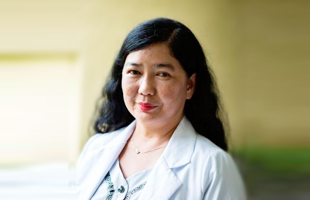
Dr Ilya Tac-an, who heads the STD/AIDS Detection Unit at the Cebu City Health Department, is a pioneer in the Philippines’ response to HIV/AIDS, working to ensure greater access to prevention, treatment and care programs for the key populations especially vulnerable to the country’s epidemic, including sex workers, men who have sex with men (MSM) and persons who inject drugs (PWID)
When did you begin to focus on addressing the challenge of HIV/AIDS, and how have your efforts expanded over time?
I entered the Cebu City Health Department after I did my Field Epidemiology Training Program in 1990 – 1992 where one of my research studies was on HIV surveillance. I then took over the STI/HIV programs under the Social Hygiene Clinic in Cebu City and have been here ever since.
In 1989 there were only three known HIV positive cases in Cebu. We knew that was not the real picture. Then, in 1992 there was a significant outbreak of malaria, in a supposedly malaria-free city. Many of the malaria cases turned out to be people who inject drugs who had acquired the infection through the sharing of needles and syringes. It was a wake-up call for us about the existence of the injecting drug problem in Cebu, although at that time the HIV prevalence among PWID was low. It was only in 2011 that the HIV prevalence among this key population increased from less than 1% to over 53%.
Under a USAID-funded HIV/AIDS surveillance and education programme, the Cebu City Health Department handled HIV surveillance – that was our primary focus, tracking the epidemic and strategizing prevention and treatment programs. HIV awareness and education fell to various NGOs that represented key populations. That division of labour in many ways continues even today, although our Cebu Social Hygiene Clinic is far more involved now in advocacy and communications as well, realizing that we cannot separate it from epidemiology, testing and treatment.
More than three decades into the global epidemic, what is the attitude of wider society towards HIV and affected populations now, and how does that impact your work?
There are definite challenges in societal attitudes towards MSM, transgender populations and of course PWID who make up a significant proportion of persons living with HIV in Cebu. Improvements are being made through the work of NGOs who try to put a human face to the epidemic, but attitudes towards HIV and those impacted by it are hard to change across wider society.
A particular challenge is for HIV positive individuals to reveal their status with anyone for fear of stigmatization and retribution, including from their families and loved ones. Thus we need to sensitize families too. There are so many stereotypes and myths about HIV and those who are vulnerable to it that continue to persist.
Political leadership and support for the wider HIV cause, and in particular for key populations, goes up and down over the years. The biggest challenge remains the ability to work effectively with persons who use drugs, who remain perhaps the most stigmatized key population in our society. This stigma hampers our work as well.
WHO and other health partners have defined harm reduction as a best practice when it comes to addressing HIV and related issues. What are the challenges in implementing these guidelines here?
In recent years we have accumulated concrete evidence from the epidemiology that the HIV epidemic among PWID is a genuine and escalating crisis, and we are seeking increased support from government and law enforcement authorities in partnering with us to address this. In 2008 almost all HIV transmission, 90 percent, was mainly through sexual contact, but just four years later it was through injecting drug use. HIV prevalence among PWID in Cebu is close to 60 percent. Almost 95 percent of PWID here have hepatitis C. Such shocking statistics are not that surprising. Needle-sharing is so common but safe needle exchange is not widely practiced, plus it is criminalized.
There are challenges in separating the country’s efforts against drug trafficking on one hand with attitudes towards drug users on the other hand. From a public health perspective we should focus on harm reduction for those who use drugs, while law enforcement could focus on ensuring that drug trafficking is addressed. Not only in the Philippines, but in many other countries it is challenging to roll out harm reduction programs given the political and legal complexities of the situation.
As you point out, WHO has categorically stated that harm reduction needs to be done strategically and openly to have maximum impact. Even though some top officials and some of the police and national players as well support the idea of harm reduction in principle, carrying it out is so difficult because it remains criminalized.
Given these challenges, what is the way forward?
We are encouraged by moves towards possibly allowing harm reduction efforts to be piloted in order for more evidence to be gathered and documented, which in turn will hopefully help guide and change health and legal frameworks that currently exist. We must better educate politicians, police, the church and the public at large about the realities.
It is a long-term process. But as the Hippocratic Oath goes, we must “above all do no harm” – the health of all citizens must be a priority.
